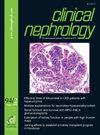Physical functional capacity assessment in children with chronic kidney disease: A cross sectional observational study.
IF 1
4区 医学
Q3 UROLOGY & NEPHROLOGY
引用次数: 0
Abstract
BACKGROUND Chronic kidney disease (CKD) leads to reduced muscle mass and strength in children resulting in a decrease in functional capacity. The objectives of this cross-sectional observational study were to evaluate and compare the functional capacity and muscle strength in children with CKD stage I - V (group A), on dialysis (stage VD) (group B), and kidney transplant recipients (KTR) (group C) in Indian children. MATERIALS AND METHODS 60 children, 20 each in groups A, B, and C were enrolled. Children who could not do the tests and transplant recipients within 6 months of transplantation were excluded. Functional capacity and muscle strength were assessed by 6-minute walk distance (SMWD), timed floor-to-stand test (TFTS), and hand grip strength (HGS). RESULTS The mean age of the group was 12.54 ± 2.96 years. Among groups A, B, and C, the SMWD in meters (465.90 ± 68.85, 381.45 ± 50.88, 509.05 ± 43.37), TFTS in seconds (9.93 ± 1.77, 10.36 ± 1.30, and 7.68 ± 0.76), and HGS in kg were (12.7 ± 3.85, 10.4 ± 3.02, 19.75 ± 4.45), respectively (p < 0.001). Group C had the best physical functional capacity. The SMWD and HGS had a moderate positive correlation (r = 0.658, 0.658, respectively), and TFTS had a negative correlation (r = -0.605) with estimated glomerular filtration rate (eGFR). The mean HGS and TFTS were different between groups A, C, and B, C (p < 0.05) and not between A and B. The SMWT was however different between A, B, and C (p < 0.001). CONCLUSION Muscle strength and functional capacity were most impaired in Indian children on hemodialysis and best preserved in KTR.慢性肾病患儿的身体机能评估:横断面观察研究
背景:慢性肾脏病(CKD)会导致儿童肌肉质量和力量下降,进而降低功能能力。这项横断面观察性研究旨在评估和比较印度儿童中 CKD I - V 期(A 组)、透析期(VD 期)(B 组)和肾移植受者(KTR)(C 组)的功能能力和肌肉力量。无法进行测试的儿童和移植后 6 个月内的移植受者被排除在外。功能能力和肌肉力量通过 6 分钟步行距离(SMWD)、定时从地面到站立测试(TFTS)和手握力(HGS)进行评估。 结果该组平均年龄为(12.54 ± 2.96)岁。A、B、C三组的SMWD(米)(465.90±68.85、381.45±50.88、509.05±43.37)、TFTS(秒)(9.93±1.77、10.36±1.30、7.68±0.76)和HGS(公斤)分别为(12.7±3.85、10.4±3.02、19.75±4.45)(P<0.001)。C 组的身体功能能力最好。SMWD和HGS与估计肾小球滤过率(eGFR)呈中度正相关(r = 0.658,0.658),TFTS与估计肾小球滤过率(eGFR)呈负相关(r = -0.605)。A 组、C 组和 B 组、C 组之间的平均 HGS 和 TFTS 有差异(p < 0.05),而 A 组和 B 组之间则没有差异。
本文章由计算机程序翻译,如有差异,请以英文原文为准。
求助全文
约1分钟内获得全文
求助全文
来源期刊

Clinical nephrology
医学-泌尿学与肾脏学
CiteScore
2.10
自引率
9.10%
发文量
138
审稿时长
4-8 weeks
期刊介绍:
Clinical Nephrology appears monthly and publishes manuscripts containing original material with emphasis on the following topics: prophylaxis, pathophysiology, immunology, diagnosis, therapy, experimental approaches and dialysis and transplantation.
 求助内容:
求助内容: 应助结果提醒方式:
应助结果提醒方式:


